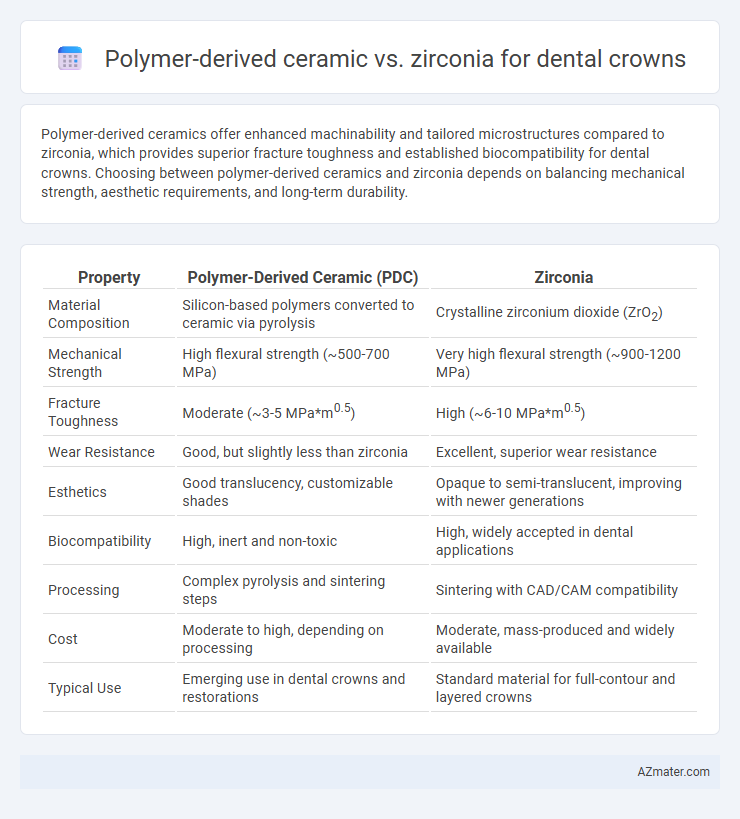Polymer-derived ceramics offer enhanced machinability and tailored microstructures compared to zirconia, which provides superior fracture toughness and established biocompatibility for dental crowns. Choosing between polymer-derived ceramics and zirconia depends on balancing mechanical strength, aesthetic requirements, and long-term durability.
Table of Comparison
| Property | Polymer-Derived Ceramic (PDC) | Zirconia |
|---|---|---|
| Material Composition | Silicon-based polymers converted to ceramic via pyrolysis | Crystalline zirconium dioxide (ZrO2) |
| Mechanical Strength | High flexural strength (~500-700 MPa) | Very high flexural strength (~900-1200 MPa) |
| Fracture Toughness | Moderate (~3-5 MPa*m0.5) | High (~6-10 MPa*m0.5) |
| Wear Resistance | Good, but slightly less than zirconia | Excellent, superior wear resistance |
| Esthetics | Good translucency, customizable shades | Opaque to semi-translucent, improving with newer generations |
| Biocompatibility | High, inert and non-toxic | High, widely accepted in dental applications |
| Processing | Complex pyrolysis and sintering steps | Sintering with CAD/CAM compatibility |
| Cost | Moderate to high, depending on processing | Moderate, mass-produced and widely available |
| Typical Use | Emerging use in dental crowns and restorations | Standard material for full-contour and layered crowns |
Introduction to Dental Crown Materials
Polymer-derived ceramics (PDC) and zirconia are prominent materials used in dental crowns, each offering distinct advantages in biocompatibility and mechanical strength. Zirconia crowns provide superior fracture toughness and wear resistance, making them suitable for high-stress molar restorations, while polymer-derived ceramics offer a combination of flexibility and esthetic translucency closer to natural teeth. Advances in polymer-derived ceramic technology have enhanced their chemical stability and durability, positioning them as a versatile alternative in restorative dentistry.
Overview of Polymer-Derived Ceramics
Polymer-derived ceramics (PDCs) offer a unique combination of high strength, chemical stability, and excellent wear resistance, making them a promising alternative to traditional zirconia for dental crowns. Synthesized through the pyrolysis of preceramic polymers, PDCs enable tailored microstructures that enhance durability and esthetic outcomes. Their inherent biocompatibility and reduced brittleness provide improved shock absorption compared to zirconia, supporting long-term oral health and comfort.
Understanding Zirconia as a Dental Material
Zirconia is a high-strength ceramic widely favored in dental crowns due to its exceptional fracture toughness, biocompatibility, and resistance to wear and corrosion. Compared to polymer-derived ceramics, zirconia offers superior mechanical stability and long-term durability, making it ideal for posterior crowns subjected to high masticatory forces. Its aesthetic properties can be enhanced through transcriptional shading and glazing, enabling lifelike restoration appearances that meet both functional and cosmetic demands.
Mechanical Strength: Polymer-Derived Ceramic vs Zirconia
Polymer-derived ceramics exhibit high fracture toughness and flexural strength, typically ranging from 300 to 600 MPa, making them resilient under occlusal forces in dental crowns. Zirconia crowns demonstrate superior mechanical strength, with flexural strength values between 900 and 1200 MPa, contributing to their widespread use for durability and long-term performance. Despite lower strength than zirconia, polymer-derived ceramics offer enhanced machinability and resistance to crack propagation, presenting a balance between strength and restorative versatility.
Aesthetic Outcomes and Color Stability
Polymer-derived ceramics offer superior aesthetic outcomes for dental crowns due to their translucency and ability to closely mimic natural tooth enamel, enhancing color integration with surrounding teeth. Zirconia crowns exhibit exceptional color stability and resistance to discoloration over time, maintaining a consistent appearance even in challenging oral environments. While polymer-derived ceramics excel in achieving lifelike translucency, zirconia provides durable, long-lasting color retention essential for patients prioritizing long-term crown aesthetics.
Biocompatibility and Patient Safety
Polymer-derived ceramics exhibit exceptional biocompatibility due to their inert chemical composition and resistance to corrosion, reducing the risk of adverse tissue reactions in dental crown applications. Zirconia crowns are also highly biocompatible, featuring minimal bacterial adhesion and strong resistance to wear and fracture, making them safe and durable for long-term oral use. Both materials support patient safety, but polymer-derived ceramics offer enhanced customization and reduced metal ion release, which can be beneficial for patients with metal sensitivities.
Longevity and Wear Resistance
Polymer-derived ceramics exhibit enhanced toughness and resistance to microcracks, promoting longer lifespan in dental crowns compared to traditional zirconia, which is prone to low-temperature degradation affecting its durability. Zirconia crowns offer superior wear resistance and strength, making them highly effective for withstanding masticatory forces, yet polymer-derived ceramics provide better resilience against chipping and fracture over time. Studies indicate polymer-derived ceramics maintain structural integrity under cyclic loading, contributing to sustained clinical performance and optimal longevity in restorative dentistry.
Tooth Preparation and Clinical Procedure
Polymer-derived ceramics require less invasive tooth preparation due to their high strength and ability to bond well with resin cements, allowing for minimal reduction of tooth structure compared to zirconia crowns. Zirconia crowns often need more aggressive tooth reduction to achieve proper thickness and strength, impacting pulp vitality risk in clinical procedures. Clinicians favor polymer-derived ceramics for conservative preparations and simplified bonding protocols, while zirconia demands precise margin design and longer sintering times during fabrication.
Cost Comparison and Accessibility
Polymer-derived ceramic dental crowns generally offer a cost-effective alternative to zirconia crowns due to lower material and manufacturing expenses, making them more accessible for patients seeking affordable dental restorations. Zirconia crowns, while more expensive, provide superior durability and aesthetic appeal, often justifying their higher price in long-term clinical performance. Accessibility to polymer-derived ceramic crowns is increasing with advancements in CAD/CAM technology, but zirconia remains the preferred material in many high-end dental practices due to its established reliability and strength.
Final Recommendations: Choosing the Right Crown Material
Polymer-derived ceramics offer excellent toughness and flexibility, making them suitable for patients requiring crowns with enhanced fracture resistance and aesthetic qualities. Zirconia crowns provide superior strength, biocompatibility, and long-term durability, ideal for posterior restorations under high occlusal loads. Final recommendations suggest selecting polymer-derived ceramics for anterior regions prioritizing aesthetics and zirconia for posterior crowns demanding maximum strength and wear resistance.

Infographic: Polymer-derived ceramic vs Zirconia for Dental crown
 azmater.com
azmater.com